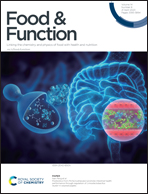Microencapsulation of olive mill wastewater in Saccharomyces cerevisiae cells by spray drying and in vitro bioaccessibility of phenolic compounds†
Abstract
Olive-mill wastewater (OMW), a by-product with high biological value and rich in phenolic compounds, is converted into spray-dried powders by using baker's yeast cells (YCs) as the carrier material. The encapsulation of OMW into YCs was also confirmed by Fourier transform infrared spectroscopy (FT-IR) analysis. The encapsulation yield (%) of powders for OMW phenolics was determined as 5.42 ± 0.33 and 4.02 ± 0.01% in YC microparticles non-treated and treated with high-pressure homogenization (HPH), respectively. The distorted structure of YCs, observed in scanning electron microscopy images, reduced the retention of OMW phenolics by YCs. HPH application made water removal easier, and the moisture content of YC-OMW powders was reduced from 5.13 to 3.72%. Compared to free OMW, the bioaccessibility indices (BI%) of individual phenolics were increased through yeast encapsulation, at the end of the intestinal stage, hydroxytyrosol and oleuropein could still be detected in encapsulated samples (BI% of 14–25 and 124–189%), but not in free OMW. Thus, YCs could be considered suitable encapsulating agents and show promising characteristics for technological application.



 Please wait while we load your content...
Please wait while we load your content...